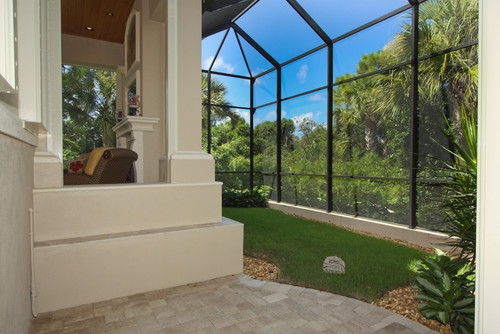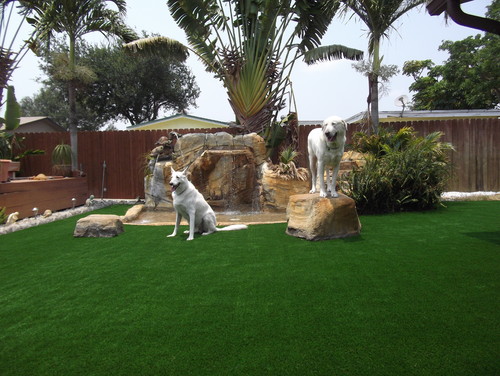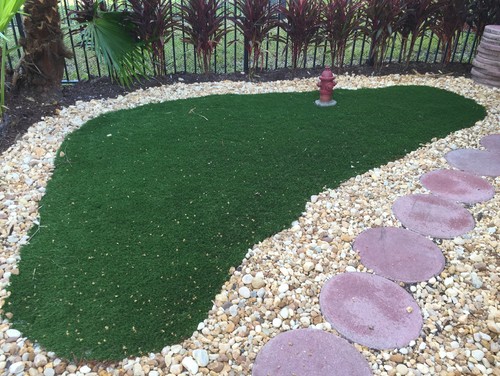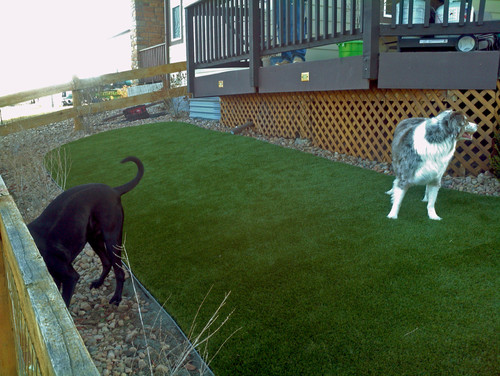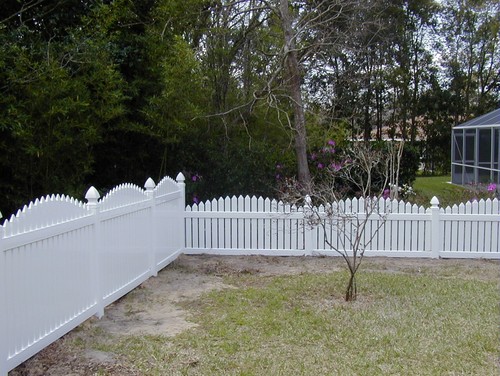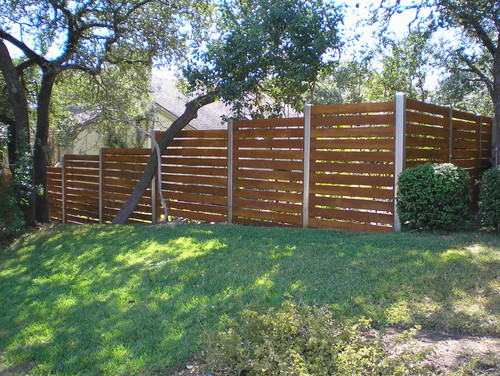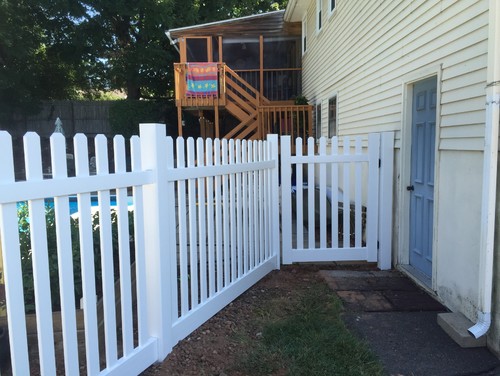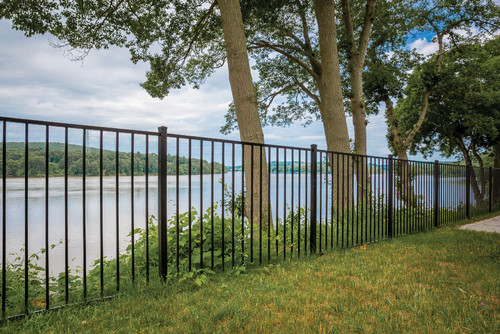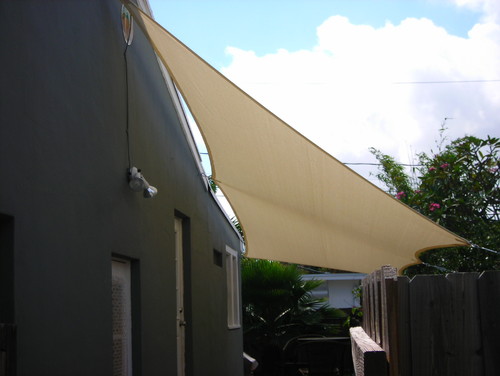Are you toying with the idea of setting up a dog run in your backyard? Well, we are here to help. We have tips on what you need to think about and a look at inspirational projects that will help you design the perfect dog run.
Why have a dog run?
When designed properly, dog runs offer several benefits for dog owners. For starters, they dedicate a specific area of your yard to your furry friend. This means the rest of your outdoor space stays clean and free from dog waste, preventing grass damage and unwanted digging.
Plus, a dog run provides a safe, secure place for your dog to enjoy the outdoors when you’re not there to supervise. While you shouldn’t leave your dog outside all the time, for those who enjoy being in the fresh air, a well-designed area can be a perfect solution.
Do all dogs like to be outside?
The short answer to this is…No. There are certain breeds that like the outdoors and others that don’t. Companion dogs, like the Maltipoo and mini goldendoodle would hate to be stuck outside alone. It’s also not safe for small dogs to be outside without supervision.
However, hunting and retriever type dogs might prefer more time than just an occasional trip outside to potty.

Dream Dog Run Ideas
Before getting in the planning stage of the project, let’s start with some inspirational photos of dream dog runs.
1.Our first dream dog run is located in Miami and is the handywork of Progressive Design Build. Here they created a dog run with a private entrance and screened in enclosure.
2. Our next dream run is truly a special spot for the family dogs. It includes a dog pool, flat rocks to play on and artificial grass to keep the area neat and clean.
3. This next one comes with its own fire hydrant and is fenced in with a contemporary metal fence. They used plants to screen it from the pool deck.
4. This dog area, situated in Denver, features synthetic grass within a fenced-in space adjacent to the deck, providing easy access for the pups.
5. Our next area is surrounded by a metal fence and includes a dog house for their pup with plenty of shade.
6. In our last inspirational photo a tall metal fence was used to section off part of the backyard. The area has easy access through a door to the house.
Looking for other dog friendly home ideas? Check out out posts on Under the Stairs Dog House, Kennel and Dog Nooks, 53+ Dog Room Ideas and Outdoor Dog Potty Area Ideas, and Tips.
Planning Your Dog Run
When planning your dog run you need to think about where to place it, how you will contain your pup and what type of ground cover you will use. Here we will go through each item:
1. Location
Choosing the right location is crucial to its functionality and your pet’s enjoyment. When selecting a spot in your yard, there are several key factors to consider:
- Sun Exposure: Think about how much sun the area gets throughout the day. While some sun is beneficial, too much can make the space uncomfortably hot for your dog, especially in summer. Look for a location that offers a balance of sun and shade. This can be naturally occurring shade from trees or buildings, or you might need to create shade with structures or covers.
- Drainage: Proper drainage is essential to keep the area clean and prevent it from becoming muddy and unpleasant. Avoid areas where water tends to collect, and consider the natural slope of your yard. In flat areas, you may need to install artificial drainage solutions, such as gravel layers or drainage tiles, to ensure that rainwater doesn’t pool inside the run.
- Proximity to the House: The area should be easily accessible. Also, consider the view from your house; you’ll want to keep an eye on your dog when they’re outside. Placement near a back door or within view of a kitchen window can be ideal. However, it’s also important to maintain a distance that keeps the run’s smells for everyone inside.

2. Size and Layout
When designing a dog run, the size and layout are critical to ensure it meets the needs of your dog, providing enough space for exercise, play, and relaxation. Here are some guidelines to help you determine the appropriate size for your run.
Breed and Size Considerations: The breed and size of your dog play a significant role in determining how much space is needed. Generally, the dog run should be at least six times the length of your dog in length and two to three times their length in width. This will allow ample room for them to sprint and roam. However, the bigger, the better, especially for active breeds.
Layout Design: The layout should be designed with your dog’s behavior and preferences in mind. For dogs that enjoy running, a longer, linear space is ideal. If your dog loves exploring, consider incorporating landscaping features that provide mental stimulation, such as different textures and heights. For families with multiple dogs, ensure there’s enough room for all dogs to play without overcrowding.
Zoning: Think about creating different zones within the run for various activities. Include an open area for running and playing, a shaded section for resting, and perhaps a sandbox for digging if your dog enjoys such activities.
Safety and Comfort: Ensure the layout includes safe, comfortable areas for your dog to rest. Soft, shaded areas away from the play zones are essential, especially in warmer climates. Also, consider the positioning of water stations; they should be easily accessible and located in a shaded area to keep the water cool.
Accessibility: Plan for easy access to the area for both your dog and yourself. Consider how you will enter the area for playtime, cleaning, and maintenance. Gates should be wide enough to allow equipment through and positioned for convenient access from the house or main yard.
3. Ground Cover
Choosing the right ground cover is essential for the area’s maintenance. While the location plays a role in this decision, the specific material you select for the ground can significantly affect the usability and longevity of the dog run. Here’s a look at some of the options:
Natural Grass: Grass is soft and natural, making it comfortable for dogs to run and lie on. However, it requires regular maintenance, including watering, mowing, and fertilization. Grass can also become muddy in rainy weather and may not withstand heavy use without wearing thin, leading to patches of dirt as you can see in the picture above.
Pea Gravel: This is a popular choice for dog runs because it’s easy on paws, provides excellent drainage, and is relatively easy to keep clean. Pea gravel doesn’t hold onto odor and can be raked or hosed down to remove waste. However, it can get hot in direct sunlight and may require periodic topping up as the stones get displaced over time.
Artificial Turf: Pet friendly, high-quality artificial turf mimics the look and feel of natural grass without the maintenance. It’s durable, provides good drainage when installed correctly, and is easy to clean. Plus, it stays green year-round. The downsides are that this is not a DIY project for most people and the initial cost may be much higher.
Concrete: Concrete is a durable and easy-to-clean option for dog runs, needing little maintenance and ideal for areas needing regular sanitizing. However, its hard surface can be tough on dogs’ joints, particularly for older pets or those prone to joint problems. Moreover, concrete can get very hot in direct sunlight and become slippery when wet, posing additional risks for your dog.
4. Fencing
When selecting a fence, it’s crucial to balance safety, security, and your dog’s happiness. Here’s a breakdown of what you need to consider:
Safety and Security
- Height: Ensure the fence is tall enough to prevent your dog from jumping over. Larger breeds or agile dogs might require taller fencing to keep them contained. I knew a large German Shepherd that could easily jump a six-foot-high chain-link fence when she wanted to.
- Material: Choose durable materials that can withstand both your dog’s behavior (like chewing or digging) and harsh weather conditions without deteriorating.
- Spacing: The gaps between slats or wires should be small enough to prevent your dog from squeezing through or getting stuck.
- Edges: Ensure the fence has no sharp edges or points that could cause injury to your dog.
- Hazards: Ensure the location is free from potential hazards, such as toxic plants or sharp objects. The area should also be secure, away from traffic and away from any wildlife that could pose a threat to your pet.
- Theft: If dog-napping is a concern:
- Use high-quality, tamper-proof locks on gates.
- Opt for fencing that cannot be easily climbed or cut through.
- Position the dog run within clear view from your house.
- Don’t leave dogs outside when no one is keeping an eye on them.
Visibility
- Consider if you want your dog to be able to see out. A solid fence offers privacy and can minimize barking at outside distractions, whereas chain-link or wire fences provide greater visibility and better air circulation. A combination of the two could be optimal: use a solid fence on the side facing public areas for privacy and an open fence on the sides overlooking your yard for visibility.

Escape-Proofing The Enclosure
- Digging: For diggers, consider burying chicken wire or a similar barrier beneath the fence line to discourage digging. Alternatively, installing a concrete footer around the perimeter can help prevent escape attempts underground.
- Climbing: Choose a fence that does not have foot holds like a chain-link fence. Adding extensions or an angled inward top can deter climbers.
- Covered Runs: For high jumpers or climbers, consider a covered dog run or a roof of some kind to prevent escape over the top.
- Secure Fencing: Inspect the entire length of the fence regularly for any weak spots, holes, or gaps that could be exploited. Ensure there are no areas where the fence is too low or where it could be easily climbed.
Dog Run Fencing Options
- Chain Link: A traditional choice due to its durability and visibility. However, some find it less attractive, and clever dogs may learn to climb it.
Wood: Offers a natural look that can complement your yard beautifully. It provides privacy and can be customized to various heights. However, it requires maintenance to prevent weathering and decay.
Vinyl: A low-maintenance alternative to wood, vinyl fencing is durable, doesn’t require painting, and can withstand the elements well. It’s also resistant to dog chewing.
Metal Panels: Prefabricated metal panels can offer a modern look and are incredibly durable. They’re also difficult for dogs to climb or chew through.
Combination Materials: You are not restricted to just one type of material. In the picture above they installed a wooden frame with a metal mesh insert.
5. Shade and Shelter
Shade
Dogs, like humans, can suffer from overheating and sunburn, especially in the warmer months. Providing ample shaded areas helps prevent heatstroke. Trees can offer natural shade, but in areas where natural shade is scarce, alternative solutions like a pergola, shade sails, or even specially designed dog canopies can be installed to create cool, protected areas. The choice of shade structure should consider the sun’s movement throughout the day to ensure consistent shade is available.
Shelter
A shelter within the dog area serves multiple purposes. It provides a refuge from sun, rain, wind, and even snow. Shelters can range from simple waterproof canopies to insulated dog houses, depending on the climate and your dog’s needs. For colder climates, an insulated shelter with bedding can keep your dog warm, while in hotter areas, a shelter with ventilation and cooling mats can offer a respite from the heat.
For more dog friendly home ideas visit; Dog Wash Station Ideas for Home, and 8 Reasons to have a Dedicated Dog Bath at Home with Inspirational Photos
Building A Dog Run
After planning your dog run and choosing the materials you will use it’s time to build it. Start by:
1. Preparing the Site
- Clear the Area: Remove any debris, rocks, and hazardous materials from the selected spot.
- Level the Ground: Ensure the area is flat and has a slight slope for drainage if necessary.
- Install Drainage (If Needed): For areas with poor natural drainage, consider installing a drainage system before adding the ground cover.
2. Install Fencing
- Mark the Perimeter: Use stakes and string to mark the boundaries of the dog run.
- Dig Post Holes: Depending on the type of fence, dig holes for the posts at the recommended depth and distance apart. Make sure to check for underground utilities before you dig.
- Set Posts: Place the posts in the holes and secure them with concrete or packed soil, ensuring they are straight and at the correct height.
- Attach Fencing: Once the posts are set, attach the fencing material, ensuring there are no gaps or sharp edges.
In the project above by Wild Landscape Design, there was a concern that the dog might dig holes, so a flexible plastic hardscape seeded with native, no-mow grasses was installed. The Picture below is the finished product.
3. Add Ground Cover
- Prepare the Base: For certain types of ground cover, like pea gravel or artificial turf, prepare a base layer of crushed stone for drainage.
- Install Ground Cover: Spread or lay down your chosen ground cover evenly across the area.
7. Add Amenities
- Install Shade Structures: Set up a canopy, shade sail, or plant trees to provide ample shade.
- Set Up Water Station: Ensure there’s a constant supply of fresh water, possibly with an automatic refilling bowl.
- Add Toys/Equipment: Place durable toys and agility equipment for exercise and entertainment.
Having a private, at-home dog run offers numerous benefits, providing a safe and controlled environment where your dog can play, exercise, and relax.
From choosing the right location, selecting durable materials for fencing and ground cover, to incorporating essential elements like shade, shelter, and security measures, creating an ideal dog run requires thoughtful planning and consideration of your dog’s specific needs and preferences.

